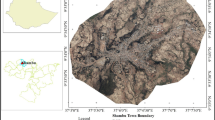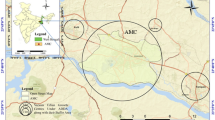Abstract
Urban expansion on agricultural land is driven by rapid population growth and is seen as a critical problem in Sub-Saharan African countries. This study was attempted to analyze the dynamics of urban expansion and land use land cover (LULC) changes using geospatial techniques in Addis Ababa City. In the present study, rate and extent of built-up area as well as changes of LULC types were derived from multispectral band of Landsat 5 TM (1990), Landsat 7 ETM + (2003), and Landsat 8 OLI/TIRS (2020), respectively. The expansion of built-up area in the periphery of the city was generated by using supervised classification method with maximum likelihood algorithm from 1990 to2020. The result of the study shows that built-up area was the most dominated LULC types in the study area from 1990 to 2020. Consequently, built-up area was increased by the rate of 2.77km2/year in the past three decades whereas agriculture and grassland were decreased by the 2.68 km2/year and 1.78 km2/year, respectively, over the study period. The results show that the built-up area was increased by an area 83.2km2 while agriculture and grassland were decreased by 80.4km2 and 53.4km2 from 1990 to 2020, respectively. Agriculture and grassland were converted to built-up area by an area of 41.1km2 and 17.3km2, from 1990 to 2020, respectively. This is mainly because of rapid expansion of built-up area and declined of agricultural land and grassland in the periphery of the city. To minimize the rapid expansions of built-up area on agricultural and grassland, the city planners should look other land use types like bare land. Moreover, urban agriculture should be promoted in the periphery of the city. This study can help to improve land use policy and enhance public understanding on the dynamics of LULC change and its implications on sustainable land management around big cities. The use of Geographic Information System (GIS) in urban planning and land use management is essential not optional to minimize the anticipated impacts of urban expansions on agricultural and other LULC classes.





Similar content being viewed by others
Data availability
Available in this manuscript.
References
Abebe MS, Deribew KT and Gemeda DO (2019) Exploiting temporal spatial patterns of informal settlements using GIS and remote sensing technique: a case study of Jimma city, Southwestern Ethiopia. Environ Syst Res. 8 (6). https://doi.org/10.1186/s40068-019-0133-5.
Abo-El-Wafa H, Yeshitela K, Pauleit S (2018) The use of urban spatial scenario design model as a strategic planning tool for Addis Ababa. Landsc Urban Plan 180:308–318
Abraham T, Tilashwork Ch, Tesfaye F, Abdlesemed J (2016) Impact assessment of land use/ land cover change on soil erosion and rural livelihood in Andit Tid Watershed, North Shewa Ethiopia. Arch Curr Res Int 3(1):1–10
Bisrat KA, Gizaw MTS, Gerrit HS, Tsegaye T (2018) Influence of urbanization-driven land use/cover change on climate: the case of Addis Ababa, Ethiopia. Physics and Chemistry of the Earth 105:212–223
Central Statistical Agency (CSA) (2007) Summary and statistical report of the 2007 population and housing census. Federal Democratic Republic of Ethiopia Population Census Commission, Addis Ababa, Ethiopia
Deribew KT, Dalacho DW (2019) Land use and forest cover dynamics in the North eastern Addis Ababa, central highlands of Ethiopia. Environ Syst Res 8:8. https://doi.org/10.1186/s40068-019-0137-1
Deribew KTS (2020) Spatiotemporal analysis of urban growth on forest and agricultural land using geospatial techniques and Shannon entropy method in the satellite town of Ethiopia, the western fringe of Addis Ababa city. Ecological Processes 9:46. https://doi.org/10.1186/s13717-020-00248-3
Eyasu E, Weldemariam S, Bereket T, Wondwosen G (2019) Impact of land use/cover changes on Lake Ecosystem of Ethiopia central rift valley. Cogent Food & Agriculture 5:1595876
Fenta AA, Yasudaa H, Haregeweyn N, Belay AS, Hadushb Z, Gebremedhine MA and Mekonnene G (2017) The dynamics of urban expansion and land use/land cover changes using remote sensing and spatial metrics: the case of Mekelle City of northern Ethiopia. Int J Remote Sens 38(14):4107–4129
Feyisa GL, Dons K, Meilby H (2014) Efficiency of parks in mitigating urban heat island effect: an example from Addis Ababa. Landsc Urban Plan 123:87–95
Kasa L, Zeleke G, Alemu D, Hagos F and Heinimann A (2015) Impact of urbanization of Addis Abeba city on peri-urban environment And livelihoods. https://www.researchgate.net/publication/267802706
Lillesand T, Kiefer R, Chipman J (2008) Remote sensing and image interpretation, 6th edn. Wiley, New York
Mishra PK, Rai A, Rai SC (2020) Land use and land cover change detection using geospatial techniques in the Sikkim Himalaya, India. The Egyptian Journal of Remote Sensing and Space Science. 23(2):133–143
Mohamed A, Worku H, Lika T (2020) Urban and regional planning approaches for sustainable governance: the case of Addis Ababa and the surrounding area changing landscape. City and Environment Interactions 8:100050. https://doi.org/10.1016/j.cacint.2020.100050
Mohammady S, Delavar MR (2016) Urban sprawl assessment and modeling using landsat images and GIS. Model Earth Syst Environ 2:155. https://doi.org/10.1007/s40808-016-0209-4
Negassa MD, Mallie DT, Gemeda DO (2020) Forest cover change detection using Geographic Information Systems and remote sensing techniques: a spatio-temporal study on Komto Protected forest priority area, East Wollega Zone Ethiopia. Environ Syst Res 9(1):1
Regassa B, Kassaw M, Bagyaraj M (2020) Analysis of urban expansion and modeling of LULC changes using geospatial techniques: the case of Adama City. Remote Sensing of Land, 4(1-2):40–58. https://doi.org/10.21523/gcj1.20040104
Teferi E, Abraha H (2017) Urban heat island Effect of Addis Ababa City: Implications of Urban Green Spaces for Climate Change Adaptation. In: Leal Filho W, Belay S, Kalangu J, Menas W, Munishi P, Musiyiwa K. (eds) Climate Change Adaptation in Africa. Climate Change Management. Springer, Cham. https://doi.org/10.1007/978-3-319-49520-0_33
Terfa BK, Chen N, Liu D, Zhang X, Niyogi D (2019) Urban expansion in Ethiopia from 1987 to 2017: characteristics, spatial patterns, and driving forces. Sustainability 11:2973. https://doi.org/10.3390/su11102973
Warkaye S, Suryabhagavan KV, Satishkumar B (2018) Urban green areas to mitigate urban heat island effect: the case of Addis Ababa, Ethiopia. Int J Ecol Environ Sci 44(4):353–367
Weng Q, Lo CP (2001) Spatial analysis of urban growth impacts on vegetative greenness with Landsat TM data. Geocarto Int 16(4):17–25
Wubneh M (2013) Addis Ababa, Ethiopia—Africa’s diplomatic capital. Cities 35:255–269
Acknowledgements
The authors would like to acknowledge Wollega University Shambu Campus Faculty of Technology and Jimma University College of Agriculture and Veterinary Medicine for the existing facilities to conduct this research.
Author information
Authors and Affiliations
Contributions
MBM involved in research design, data collection, data analysis, and draft manuscript. DOG involved in data analysis and manuscript edition. Both authors read and approved the final manuscript.
Corresponding author
Ethics declarations
Consent for publication
The authors agreed to publish the manuscript on Journal of Applied Geomatics.
Competing interests
The authors declare no competing interests.
Rights and permissions
About this article
Cite this article
Moisa, M.B., Gemeda, D.O. Analysis of urban expansion and land use/land cover changes using geospatial techniques: a case of Addis Ababa City, Ethiopia. Appl Geomat 13, 853–861 (2021). https://doi.org/10.1007/s12518-021-00397-w
Received:
Accepted:
Published:
Issue Date:
DOI: https://doi.org/10.1007/s12518-021-00397-w




